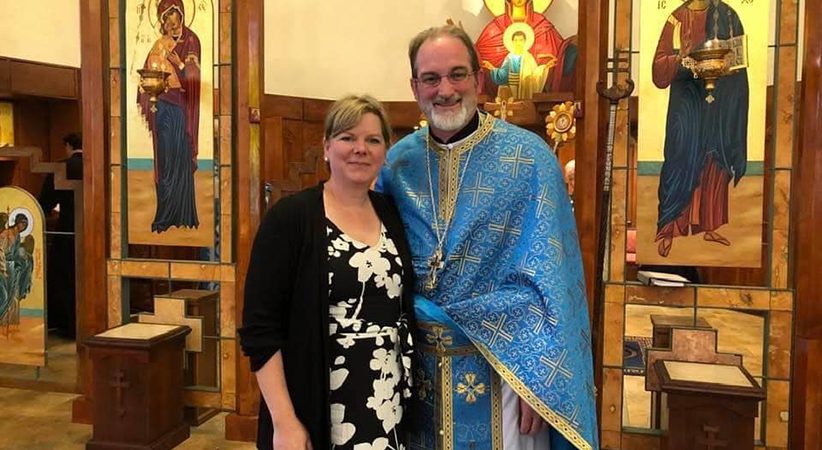Afraid of the Lord
How can we help people who dread God’s judgment to face death with peace?
Deacon Tim Healy Comments Off on Afraid of the Lord
From time to time in hospital ministry I’ve encountered people nearing the end of their lives who were genuinely frightened about the prospect of coming face-to-face with God. In a landmark study of religious belief, Baylor University researchers found in 2006 that almost 50% of Americans believed in an authoritarian or critical God. Given that statistic, I’m confident that many of my deacon brothers have met folks in prisons, nursing homes and other venues who’ve expressed similar fears and looked to them for consolation.
Our understanding of God’s mercy and judgment comes into play at such times. At the heart of this understanding lies our grasp of atonement. Let’s revisit what we learned in formation and consider how atonement can be expressed in ways that can allay fear and engender hope.
St. Anselm, in his book “Cur Deus Homo?” (“Why Did God Become Man?”), written at the end of the 11th century, built on the work of his predecessors and developed what has come to be known as the theory of substitutionary atonement in Catholic theology. You can find a concise explanation of it in the Catechism of the Catholic Church (cf. No 616).
In short, the theory states that man’s fall in Adam was of such gravity that only God, in Jesus, could remedy the damage. The key point is that out of pure love Jesus did something for us that we could not have done on our own, resulting in our access to the Father. On occasion, the way in which this doctrine has been presented has left some people with a frightening image of an angry God.
Bishop Robert Barron, in one of his daily Gospel reflections, wrote about one particularly egregious hermeneutic:
“There is a terrible interpretation of the cross that holds the view that the bloody sacrifice of the Son on the cross was ‘satisfying’ to the Father, an appeasement of a God infinitely angry at sinful humanity. In this reading, the crucified Jesus is like a child hurled into the fiery mouth of a pagan divinity in order to assuage its wrath.
“What eloquently gives the lie to this awful interpretation is today’s passage [John 3:16-18], which is often proposed as a summary of the Christian message. God the Father is not some pathetic divinity whose bruised honor needs to be restored; rather, God is a parent who burns with compassion for his children who have wandered into danger. It is not out of anger or vengeance that the Father sends the Son but precisely out of love.
“Does the Father hate sinners? No, but he hates sin. Does God harbor indignation at the unjust? No, but God despises injustice. Thus God sends his Son not gleefully to see him suffer but to set things right.”
Atonement vs. at-one-ment
I’d like to pick up on this association between parenthood and atonement, turning the jewel of orthodox Catholic doctrine in the light shed by the work of psychiatrist John Bowlby and psychologist Mary Ainsworth on attachment. I’ll also couple their insights with the importance of attunement in raising children well, as Gabor Maté and similar psychotherapists advocate. The mix provides us deacons with a rich, compassionate message of consolation and hope.
“Atonement” is a relatively recent word in English. Its first known use was in 1513, long after Anselm wrote, and it denoted “reconciliation.” Examining the word’s roots, “at” and “one,” provides insight into the original meaning. At that time, atonement meant achieving harmony; becoming one (“at”-“one”-“ment”). Deacons can readily lead people to visualize this clear, literal meaning to begin to forge a message of love and hope.
A century later, atonement came to mean “making satisfaction or reparation for wrong or injury, propitiation of an offended party.” It doesn’t take much rumination to see what damage was done to the understanding of God and God’s unconditional love when the word was used like this in theological contexts.
In its original meaning, atonement has an interesting affinity with attachment, as it is used to describe early childhood these days. For about a year and a half after they are born, babies see themselves and their mother as one. During this time, the utterly dependent baby depends on mom (and dad, to some extent) to provide all that it needs — it is “attached” to mom. The “at-one-ment” is as complete as that phenomenon can get.
If parents do a reasonably good job, their children enjoy more or less “normal attachment.” For these babies, there’s a balance between doing what they have to do to get what they need to survive and what they need to do to realize their true selves. They accept just about everything, assign salience to what they experience, for better or worse, and become increasingly aware of their own agency — the ability to do things for themselves. Eventually they become ready and capable of taking on adult life.
Good attachment is abetted by attunement. Parents begin to notice the distinct characteristics of their child and exhibit curiosity about that while simultaneously encouraging the child’s safe development. This interested interaction, encouragement, acceptance and instruction is largely what’s meant by attunement. Children thrive when they sense it in their parents. The converse also applies, and is analogous to our experience of sin and injustice, to use Bishop Barron’s words.
Abnormal attachments can develop, especially if parents did not experience reasonably normal attachment themselves. Some examples: Anxious attachment occurs when a baby senses that he or she has to perform according to specifications to earn parental attention. Avoidant attachment occurs when a baby senses that the attachment figure simply isn’t providing the needed and expected care. Disorganized attachment occurs when the child cannot depend on consistent nurturing.
Life’s pretty big, and many other factors come to bear, but we can say with some degree of certainty that the more normal our attachment experience was, the better the outcomes in our adulthood are likely to be, and vice versa.
Securely Attached
We turn a corner in our faith life when we realize that our attachment to God and God’s attunement with our deepest identity is utterly reliable and complete. Whatever deficiencies we might have experienced at the hands of our earthly parents, we can be confident that our deepest needs are always being met by God, whether we’re conscious of that or not. We don’t call God our “father” for nothing, and we don’t ascribe perfection to God for no good reason either.
That “interested interaction” and “encouragement” can be understood as the movement of the Holy Spirit within us. Likewise, the acceptance and instruction God shows us is but another way he expresses his unconditional love and guidance.
God is just, and judgment does indeed loom ahead of us, but there are many ways to express what this means, some much less fearsome than others. A gentle, loving way to explain judgment to suffering people in hospitals, prison and similar places might look like this:
Imagine that you’re baking a lovely chocolate layer cake. You mix all the ingredients together, fill the pans and put them in the oven. As the baking time nears completion, you grab a toothpick and stick it in the pans. If it comes out clean, your judgment is that the layer is ready. If it isn’t, it stays in the oven a bit longer. The judgment is about the layer’s readiness to go into your cake.
It’s much the same as a sailor making a judgment about the seaworthiness of his boat. Judgment, especially when viewed through the prism of love, is far more about readiness than performance, honor, merit or punishment. All unreadiness and unworthiness can be set right if we honestly acknowledge it and submit to the corrective actions of the loving God who is delighted to make us ready to be one with him.
Returning to atonement, we can now see that “at-one-ment” with God reflects this profound attachment and attunement far more than it describes God’s angry and bloodthirsty acceptance of compensatory satisfaction.
Approaching atonement in this way, we deacons can deliver a message of hope to suffering people to whom we minister that will leave them looking forward to encountering God face-to-face rather than fearing the meeting.
DEACON TIM HEALY is a deacon for the Archdiocese of Hartford and conducts retreats on forgiveness. He is the author of “Tales for the Masses” (CSS, $16.95) and the upcoming “More Tales for the Masses.”





